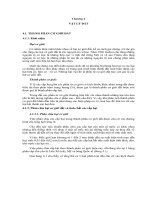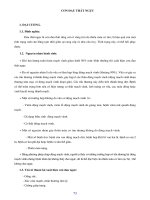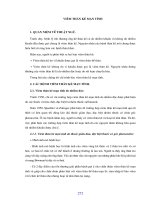GIÁO TRÌNH MARKETING NGHIÊN CỨU - PHẦN 10 pps
Bạn đang xem bản rút gọn của tài liệu. Xem và tải ngay bản đầy đủ của tài liệu tại đây (198.29 KB, 24 trang )
Measurement in
Marketing Research
Ch 10 2
Basic Question-Response Formats
•
Open-ended
•
Closed-ended
•
Scaled-response
Ch 10 3
Basic Question-Response Formats
Open-Ended
•
Open-ended question presents no
response options to the respondent.
Ch 10 4
Basic Question-Response Formats
Open-Ended: Unprobed
•
Unprobed format seeks no additional
information
–
Advantage:
•
Allows respondent to use his or her
own words
–
Disadvantages:
•
Difficult to code and interpret
•
Respondents may not give complete
answers
Ch 10 5
Basic Question-Response Formats
Open-Ended: Probed
•
Probed format includes a response
probe instructing the interviewer to
ask for additional information
–
Advantage:
•
Elicits complete answers
–
Disadvantage:
•
Difficult to code and interpret.
Ch 10 6
Basic Question-Response Formats
Closed-Ended
•
Closed-ended question provides
options on the questionnaire that can
be answered quickly and easily.
Ch 10 7
Basic Question-Response Formats
Closed-Ended: Dichotomous
•
Dichotomous has only two response
options, such as “yes” or “no”
–
Advantage:
•
Simple to administer and code
–
Disadvantage:
•
May oversimplify response options
Ch 10 8
Basic Question-Response Formats
Closed-Ended: Multiple Category
•
Multiple response has more than two
options for the response
–
Advantages:
•
Allows for broad range of possible responses
•
Simple to administer and code
–
Disadvantages:
•
Must distinguish “pick one” from “pick all that
apply”
•
May alert respondents to response options of
which they were unaware
Ch 10 9
Basic Question-Response Formats
Scaled-Response
•
Scaled-response question utilizes a
scale developed by the researcher to
measure the attributes of some
construct under study.
Ch 10 10
Basic Question-Response Formats
Scaled-Response: Unlabeled
•
Unlabeled uses a scale that may be purely
numerical or only the endpoints of the
scale are identified
–
Advantages:
•
Allows for degree of intensity/feelings to be
expressed
•
Simple to administer and code
–
Disadvantage:
•
Respondents may not relate well to the
scale
Ch 10 11
Basic Question-Response Formats
Scaled-Response: Labeled
•
Labeled uses a scale in which all of the scale
positions are identified with some description
–
Advantages:
•
Allows for degree of intensity/feelings to be
expressed
•
Simple to administer and code
•
Respondents can relate to scale
–
Disadvantage:
•
Scale may be “forced” or overly detailed
Ch 10 12
Considerations in Choosing a
Question-Response Format
•
The nature of the property being
measured
–
Gender=dichotomous; liking for
chocolate=scale
•
Previous research studies
–
Use format in previous study if
desire to compare
Ch 10 13
Considerations in Choosing a
Question-Response Format
•
The data collection mode
–
Cannot use some scales on the
phone
•
The ability of the respondent
–
Kids can’t relate to scaled
response
•
The scale level desired
Ch 10 14
Basic Concepts in
Measurement
•
Measurement: determining how much of a
property is possessed by an object
•
Properties: specific features or
characteristics of an object that can be
used to distinguish it from another object
–
Objective properties are physically
verifiable
–
Subjective properties are mental
constructs
Ch 10 15
Scale Characteristics Determine
the Level of Measurement
•
Description: the use of a descriptor, or
label, to stand for each “unit” on the
scale; “yes,” “no,” “male,” “female,” etc.
–
All levels of measurement have
description.
•
Order: the relative sizes of the
descriptors are known allowing us to say
one is “greater/less than” the other.
Ch 10 16
Scale Characteristics Determine
the Level of Measurement
•
Distance: the differences between
the descriptors are known: there is a
$1 difference between $4 and $5.
There is a 10 degree difference
between 90 and 100 degrees.
•
Origin: there is a true, natural zero:
there is a zero level of dollars, market
share, sales.
Ch 10 17
Levels of Measurement Scales
•
Nominal scales: those that use only labels
•
Ordinal scales: those with which the
researcher can rank-order the
respondents or responses
•
Interval scales: those in which the
distance between each descriptor is equal
•
Ratio scales: ones in which a true zero
exists
Ch 10 18
Levels of Measurement Scales
Ch 10 19
Why the Level of a Measurement
Scale is Important
•
The scale affects what may or may
not be said about the property being
measured.
–
Examples:
•
If you wish to calculate an average,
you must use an interval or ratio scale.
•
If you have a nominal or ordinal scale,
you must summarize the results with a
percentage or frequency distribution.
Ch 10 20
Examples of Scaling
Assumptions
Ch 10 21
Measuring Objective Properties
•
Physically verifiable characteristics
such as age, gender, number of
bottles purchased, etc.
Ch 10 22
Measuring Subjective
Properties
•
Cannot be directly observed because
they are mental constructs such as a
person’s attitudes, opinions, or
intentions.
•
For subjective properties,
researchers must translate mental
constructs onto an intensity
continuum.
Ch 10 23
Workhorse Scales Used in
Marketing Research
•
The Modified Likert Scale
•
The Life-Style Inventory
•
The Semantic Differential Scale
–
Halo effect
•
Other Scaled-Response Question
Formats
Ch 10 24
Reliability and Validity
•
Reliability: respondent responds in
the same or a similar manner to an
identical or nearly identical measure
•
Validity: accuracy of responses to a
measure
–
Face validity









